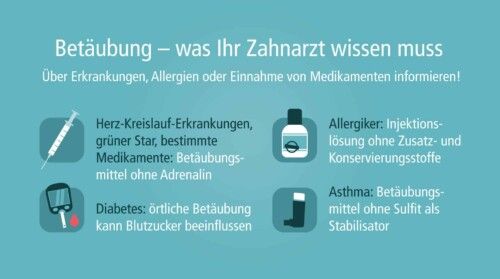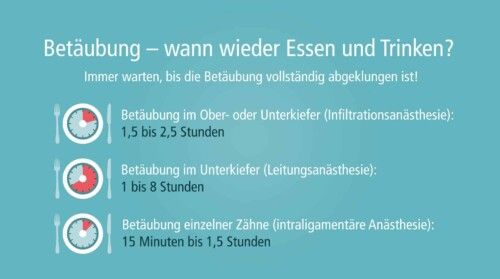
Anesthesia for dental treatment: This is important!
Modern anesthesia options are safe and largely free of side effects. Nowadays, therefore, no one has to endure pain during dental treatment.
Before anesthesia is administered, however, it is important for the dentist to know if the patient has any general illnesses or allergies, or is taking any medication.
In order to select a suitable anesthetic or procedure for anesthesia during dental treatment, the dentist records these points in a detailed anamnesis.
Many anesthetic preparations contain adrenaline. It prolongs and enhances the effects of local anesthesia and reduces blood flow to the tissues during treatment.
“Whenever possible, adrenaline should be used for local anesthesia, but in as small a dose as possible,” explains Univ.-Prof. Dr. Dr. Monika Daubländer, Chair of the Interdisciplinary Working Group on Dental Anesthesia (IAZA).
Provide information about illnesses, allergies, medications
Adrenaline must not be given in the case of various illnesses such as cardiac arrhythmia, hyperthyroidism as well as a tumor of the adrenal medulla.
As an alternative, however, there are remedies without adrenaline. Also, the adrenaline in the local anesthetic can affect blood glucose levels.
Patients with diabetes should be aware of this when taking their diabetes medication. Allergic reactions as a side effect to local anesthesia are very rare.
For patients with allergies to certain ingredients, there are injection solutions without additives and preservatives.
For example, there are anesthetics without sulfite for people with allergic asthma, as this can trigger an attack in asthmatics.
Only eat and drink when the anesthesia has worn off
Local anesthesia blocks the transmission of stimuli in the nerves for a certain period of time during dental treatment.
The local anesthetic causes the patient to feel numbness.
Stimuli such as pain, touch or temperature cannot be felt during treatment, but pressure may be.
Often the oral mucosa or sections of the jaw, and sometimes the tongue, are still numb when the dentist is finished with the treatment.
Depending on the type of anesthetic used and the technique, this can take up to several hours.
Patients are therefore best advised not to eat or drink until the anesthesia has completely worn off after treatment.
Otherwise there is a risk of injury. This can cause them to bite their still anesthetized lip or scald themselves on hot foods and drinks.
Diabetics should be especially prepared for this situation as part of their dietary habits.
An additional injection can also be used to administer a drug that allows the anesthesia of the soft tissues to wear off more quickly.

Anesthesia in the upper and lower jaws
Depending on the area of the mouth to be numbed during treatment, the dentist may use different techniques.
In the upper jaw, infiltration anesthesia is often used. The dentist places the syringe with the anesthetic solution under the mucous membrane near the root tip of the teeth to be treated.
Local anesthesia numbs individual teeth, the surrounding bone, soft tissue, small areas of the oral mucosa and, in some circumstances, the skin of the face.
Depending on the extent of the procedure, infiltration anesthesia can also be used in some cases to anesthetize the area of the front teeth and small molars in the lower jaw.
Otherwise, conduction anesthesia is suitable for the posterior areas of the lower jaw. The dentist places the syringe near the nerve that supplies the corresponding half of the mandible.
This numbs the entire conduction pathway and also causes numbness in the lower lip and often the tongue.
Anesthesia of individual teeth
With intraligamentary anesthesia, the dentist can numb individual teeth for very limited procedures.
A special syringe with a very thin needle injects the anesthetic directly into the gap between the tooth and the bone.
If another type of anesthesia is not effective enough, the dentist can also use this method additionally.
General anesthesia
In some cases, general anesthesia in cooperation with an anesthesiologist may be necessary for dental treatment.
However, general anesthesia carries significantly higher risks than local anesthesia and should only be used in medically justifiable cases.
Therefore, it is used only for patients for whom local anesthesia is not feasible or when a very extensive treatment is necessary.
In any case, general anesthesia requires the coordination and presence of an anesthesiologist.
Hypnosis or sedation can be useful in some cases for anxiety and stress reduction.

